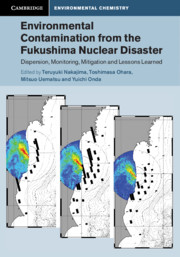 Environmental Contamination from the Fukushima Nuclear Disaster
Environmental Contamination from the Fukushima Nuclear Disaster Book contents
- Environmental Contamination from the Fukushima Nuclear Disaster
- Cambridge Environmental Chemistry Series
- Environmental Contamination from the Fukushima Nuclear Disaster
- Copyright page
- Contents
- Contributors
- Preface
- Acknowledgements
- Part I Transport of Radioactive Materials in the Environment
- Part II Development and Future Issues for the Infrastructure of Disaster Prevention
- 7 Monitoring System
- 8 Dispersion Modelling of Radioactive Materials
- 9 Off-Site Decontamination
- Part III Lessons and Future Issues from the Fukushima Accident
- Glossary
- Names of Locations
- Index
- References
8 - Dispersion Modelling of Radioactive Materials
from Part II - Development and Future Issues for the Infrastructure of Disaster Prevention
Published online by Cambridge University Press: 16 August 2019
- Environmental Contamination from the Fukushima Nuclear Disaster
- Cambridge Environmental Chemistry Series
- Environmental Contamination from the Fukushima Nuclear Disaster
- Copyright page
- Contents
- Contributors
- Preface
- Acknowledgements
- Part I Transport of Radioactive Materials in the Environment
- Part II Development and Future Issues for the Infrastructure of Disaster Prevention
- 7 Monitoring System
- 8 Dispersion Modelling of Radioactive Materials
- 9 Off-Site Decontamination
- Part III Lessons and Future Issues from the Fukushima Accident
- Glossary
- Names of Locations
- Index
- References
Summary
SPEEDI, the System for Prediction of Environmental Emergency Dose Information, is an emergency response system to predict the atmospheric dispersion of radioactive materials and radiological doses in the case of an atmospheric release of substantial radioactive materials from nuclear facilities in Japan. It has been operated by the Nuclear Safety Technology Center on consignment from the Ministry of Education, Culture, Sports, Science and Technology (MEXT) and local governments (Suda, 2006). After the accident at the Fukushima Daiichi Nuclear Power Station (FDNPS) of the Tokyo Electric Power Company (TEPCO) due to the Great East Japan Earthquake on 11 March 2011, which caused a substantial discharge of radioactive materials into the atmospheric and oceanic environments, SPEEDI became recognised by not only the nuclear emergency community but also the public at home and abroad, and the issue of its utilisation was discussed by the government, the Diet and independent accident investigations (Independent Investigation Commission on the Fukushima Nuclear Accident, 2012; Investigation Committee on the Accident at Fukushima Nuclear Power Stations of Tokyo Electric Power Company, 2012; National Diet of Japan Fukushima Nuclear Accident Independent Investigation Commission, 2012).
- Type
- Chapter
- Information
- Environmental Contamination from the Fukushima Nuclear DisasterDispersion, Monitoring, Mitigation and Lessons Learned, pp. 230 - 242Publisher: Cambridge University PressPrint publication year: 2019
